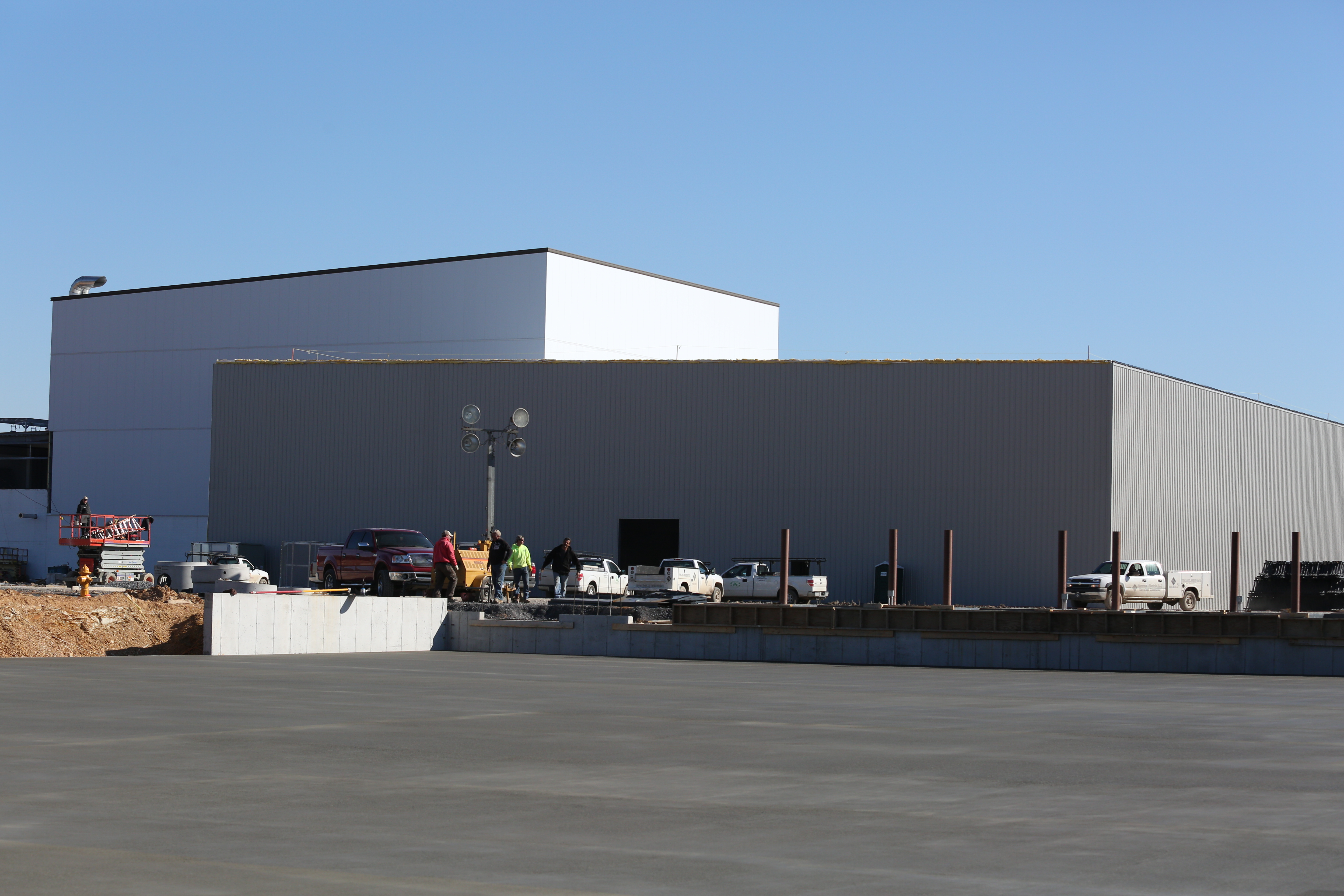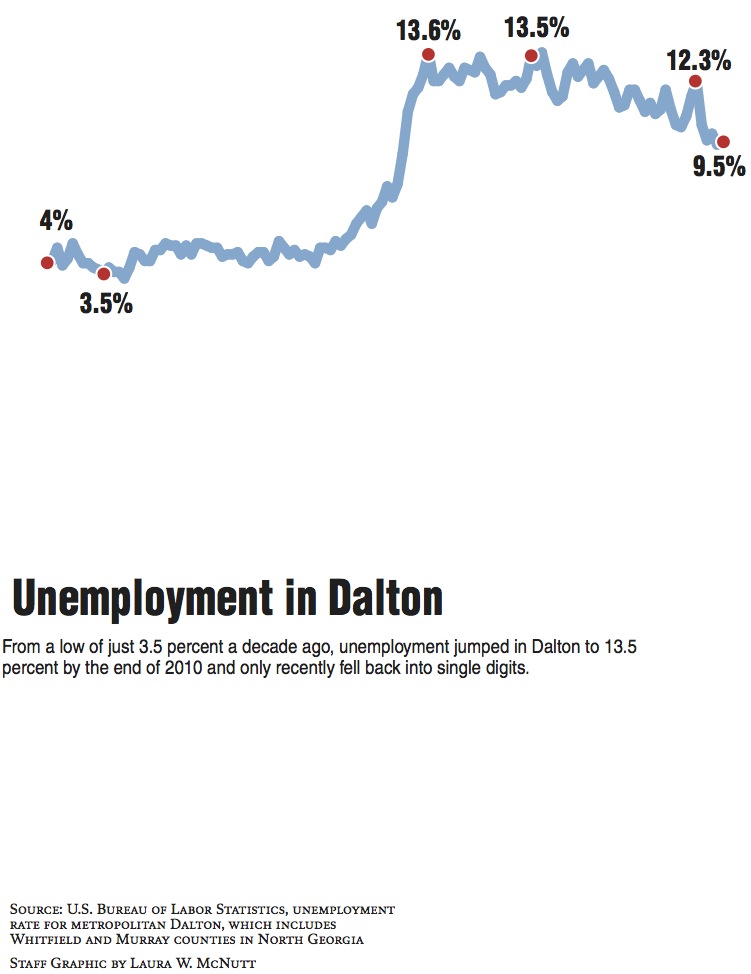Employers are hiring, but Dalton jobless rate still highest among Southern metro areas
Sunday, March 9, 2014
BY THE NUMBERSDalton workforce before and after the recession:High: 79,900, summer 2006Low: 62,700, fall 2012, matches January 1993 levelsAdding jobsIn the past year, major carpet manufacturers have announced plans to add more than 3,000 workers at reopened, new or expanded mills in Northwest Georgia:• Engineered Floors, 2,000 jobs• Shaw Industries, 600 jobs• Mohawk Industries, 420 jobs• Beaulieu of America, 200 jobsSource: Company reports
The engine of the Oldsmobile Cutlass Supreme continued to belch fumes as Mary Jane Rogers rolled down the window.
She lit the latest in an unbroken chain of discount cigarettes, exhaling a practiced stream of smoke that mushroomed off the windshield.
Rogers waited as her boyfriend, 26-year-old Carl Leonard Cochran, dashed inside the Dalton, Ga., unemployment office to look for work. Like the dozens of others filtering in and out of the Career Center, this was his last chance to find a job before the consequences of having no income began to kick in.
"We're in desperate need," Rogers explained.
One of the worst-hit cities during the Great Recession, Dalton has struggled to latch onto a recovery that has taken hold in other parts of the country.
In the intervening years, Northwest Georgia has flirted with recovery, even briefly reversing its decline several times. Major employers have announced new factories, and the jobless rate in the Dalton metro area fell to 9.5 percent from its peak in January 2010 of 13.4 percent.
But even those encouraging statistics carry a bitter truth. Dalton's jobless rate at the end of last year was still the highest among any of the top metro areas in the Southeast, and among the highest 10 percent of all 372 metro areas in the country.
Worse, much of the decrease in the jobless rate can be traced to workers who quit looking for work, packed their bags and left town permanently. The metropolitan area's workforce peaked in summer 2006 at just under 80,000 workers, but has fallen by more than 20 percent since then to 62,900 workers, if seasonally adjusted. It remains to be seen how many of those lost jobs will ultimately return to the city known as the carpet capital of the world.
Rogers, like many of the Northwest Georgia's unemployed, has yet to feel the effects of an economic recovery that government economists say began in June 2009. Dalton's workforce has continued to shrink since then, falling by 3,000 workers since the official end of the Great Recession.
"I ain't doing too hot right now," she said. "Things have been tough."
Rogers, who is disabled, is still working to get her government assistance straightened out. There's a lot of paperwork and waiting involved in being disabled, she said. She depends on her boyfriend for income. Only he doesn't have any.
"He's in there doing an application for pizza delivery," Rogers said.
Though dozens of jobless still wander in his front door every day, destitute job seekers like Rogers and Cochran are increasingly rare, said Chris Upchurch, manager of Dalton's career center. For some time, Upchurch's staff was so snowed under by unemployment applications that they had little time to help residents find a job. It was more about managing traffic as 17,000 people exited the local workforce.
But the bleeding has at least temporarily halted since September 2012, when Dalton's workforce hit a low of 62,700 workers. Since then, the number of workers in the metropolitan area has stabilized slightly, creeping toward 64,000. That's encouraging for Upchurch, who takes the improvement as a sign that manufacturers have gained enough confidence to start hiring again.
"We're finally starting to see a lot of positive," he said. "From our perspective, the challenge now is letting people know what's available."
Indeed, a search of the computerized job finding system at Dalton's career center yields a large number of results. Manufacturers such as Engineered Floors, Mohawk, Shaw, IVC US and others have announced new plants and more than 3,200 new job opportunities in the last few months.
Though Northwest Georgia's carpet industry shrank by 40 percent during the recession, it recovered by 4 percent in 2013 and is expected to grow even more this year, said Bob Shaw, founder and chairman of Engineered Floors.
"If you take new home starts, consumer confidence and various other sundry things, [the industry] is expecting to grow at 8 percent this year," Shaw said.
Shaw himself plans to double from 2,000 to 4,000 workers by 2016 as he builds a 2.4 million-square-foot manufacturing plant in Carbondale, Ga. -- approximately halfway between Dalton, Ga., and Calhoun, Ga.
Many of the thousands of new jobs created by Shaw and others are simply replacing other jobs rather than adding to the overall pie, but for most unemployed workers it makes no difference. At the career center, everyone is searching for the same thing. Thanks to the taxpayer-provided printer, fax machine and telephone, job seekers today have more resources at their disposal when searching for a new employers.
Those resources are what recently brought Debbie Grant, a certified nursing assistant, to the unemployment office for the first time in her life. Despite the strong demand for nurses across the U.S., Grant has had trouble connecting with her next employer.
"I've never had to do this before," she said. "I would work just about anywhere. I would even work in Calhoun, [Ga.]."
So would Paul Reece, a television repairman who has found himself trapped in a system originally designed to help workers.
Paid to work just one day per week at a small area retailer, he can barely make ends meet. But since he's still technically employed, he doesn't have access to the same level of government assistance as others.
"I can't quit because I can't get unemployment if I do, but to even get partial unemployment I have to be looking for a job," Reece said. "They want you to fill out 30 applications per week. The catch is that they want you to have a college degree."
So he can't quit, his employer won't fire him, and he's prevented from collecting many types of help by the fact that he's got a job. That's the chronic catch-22 suffered by those who are considered underemployed -- not jobless, but not fully employed either.
About 17.7 percent of adults are underemployed in the U.S., according to a new Gallup survey of Americans. That's more than twice the number of those who are counted as unemployed. That trend is likely to continue, Reece said, as workers whose skills are no longer in high demand -- such as TV repairmen -- must learn to cope with less.
But even the official unemployment and underemployment rates don't tell the full story, because they fail to account for workers who have totally given up on looking for work. To see the big picture, just take a look at the streets outside the unemployment center, Reece said.
"These roads out here used to be jammed up every day, there would be traffic jams during lunch," Reece said. "Now you can drive up there free and clear with no problems, because nobody's working."
Contact staff writer Ellis Smith at esmith@timesfreepress.com or 423-757-6315.



